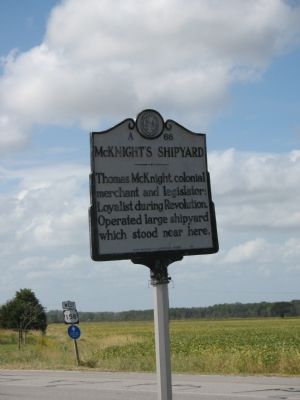Shawboro in Currituck County, North Carolina — The American South (South Atlantic)
McKnight’s Shipyard
Erected 1971 by State Department of Archives and History. (Marker Number A-66.)
Topics and series. This historical marker is listed in these topic lists: Colonial Era • Industry & Commerce • War, US Revolutionary • Waterways & Vessels. In addition, it is included in the North Carolina Division of Archives and History series list.
Location. 36° 22.643′ N, 76° 5.184′ W. Marker is in Shawboro, North Carolina, in Currituck County. Marker is at the intersection of Shortcut Road (U.S. 158) and Indiantown Road, on the right when traveling east on Shortcut Road. Touch for map. Marker is in this post office area: Shawboro NC 27973, United States of America. Touch for directions.
Other nearby markers. At least 8 other markers are within 6 miles of this marker, measured as the crow flies. Yeopim (within shouting distance of this marker); Henry M. Shaw (approx. 2 miles away); Indiantown (approx. 2.1 miles away); Former Site of Sawyer's Creek / Marian Anderson High School (approx. 5 miles away); Hijacking Maple Leaf (approx. 5.3 miles away); William Reed (approx. 5½ miles away); Isaac Gregory (approx. 5.8 miles away); Dempsey Burgess (approx. 5.8 miles away). Touch for a list and map of all markers in Shawboro.
Regarding McKnight’s Shipyard. Proclaimed by its owner “the most commodious, and . . . best shipyard in the province” with “large warfs and convenient warehouses,” McKnight’s shipyard was located on the Indiantown Creek area of the north side of the North River, which is the boundary between Currituck and Camden counties. Specific details as to the McKnight’s establishing the shipyard are lacking, but it was in operation during the colonial period. It was closed in 1775 when McKnight fled to Virginia due to local hostilities and an assassination attempt related to his very public Loyalist convictions. British Loyalist claims made by Thomas McKnight provide important information as to the size and scope of his shipbuilding operation. In one passage he recalls “From this yard I have launched a ship (one hundred feet long) into fourteen feet of water, upon sliding boards not more than thirty in length, the whole run did not exceed twenty-five feet; and from the top of the keel blocks to the surface of the water was a fall of little more than two feet.”
Little is known about Thomas McKnight’s life before he appears in North Carolina public records in 1757. He was a native of Scotland who settled in the Albemarle region and also owned property in the Cape Fear area. Aside from his shipbuilding business, McKnight organized a significant shingle-making operation in 1757, utilizing the Albemarle’s abundant juniper and cypress trees. He also became a wealthy planter, living on an 8,000-acre plantation called Belville in Currituck County. McKnight served in the North Carolina General Assembly in 1762, 1771, 1773 (both sessions), and 1775. He was nominated for the Council in 1775, described by Governor Josiah Martin as a “gentleman of character . . . of greatest weight and abilities.” At the 1775 Provincial Congress, McKnight was the only member who refused to sign the declaration commending the work of the Continental Congress at Philadelphia. With many enemies in his home state, he escaped to Virginia in 1775 but returned to North Carolina in 1776. Later in the year he fled to England where records of his Loyalist claims provide information about his life, including his shipyard, in North Carolina through details of his losses.
References:
Barbara B. Snowden, “Thomas McKnight, Local Tory, Caught “Betwix and Between,” unpublished paper, December 14, 1982, East Carolina University, copy in marker files, Research Branch, Office of Archives and History
William S. Powell, ed., Dictionary of North Carolina Biography, IV, 165—sketch by John D. Neville
Charles Christopher Crittenden, “Ships and Shipping in North Carolina, 1763-1789,” North Carolina Historical Review (January 1931): 1-13
(Elizabeth City) Daily Advance, August 6, 1993
English Papers, Loyalist Claims, North Carolina State Archives.
Robert O. DeMond, The Loyalists in North Carolina During the Revolution (1979)
copied from the North Carolina Department of Cultural Resources
Credits. This page was last revised on November 28, 2019. It was originally submitted on October 1, 2007, by Laura Troy of Burke, Virginia. This page has been viewed 1,923 times since then and 75 times this year. Photo 1. submitted on October 1, 2007, by Laura Troy of Burke, Virginia. • J. J. Prats was the editor who published this page.
Editor’s want-list for this marker. A wide shot of the marker and its surroundings. • Can you help?
